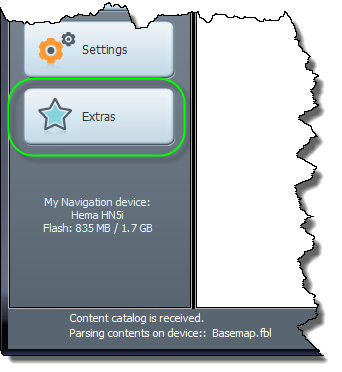Import POIs into iGO from a KML file
- HN5i
- HN6
- HN7
- HX-1
There are TWO ways to import a KML file containing POIs into iGO:
- Copy a KML file directly to the Navigator:
- For HN5i, HN6, HN7 models, specifically to the MobileNavigator\CONTENT\USERDATA\POI folder
- For HX-1, specifically to the iGO\CONTENT\USERDATA\POI folder
- Use NaviExtras Toolbox to do the copying for you as shown below:
NaviExtras Toolbox can be used to import KML files into iGO on the Navigator.
KML files might have been exported from Google Earth / Maps, or downloaded from a POI website etc. and saved on your PC beforehand.
Click the Extras button at the bottom of the left-hand toolbar in NaviExtras Toolbox.

Click the KML button to select your KML file for import.
Once the KML file has been imported, you will find the content under the list of POI categories under the Find function within iGO.
There are limits to how many POIs you can import. We have tested up to a few thousand POIs, but any more than this may affect performance.
It is beyond the scope of Hema Tech Support to answer questions regarding the creation or acquisition of KML files.

Manually Copying KML files to your HN5i, HN6, HN7 or HX-1 Navigators
If you do not understand the concept of creating folders etc. on your PC, do NOT attempt this procedure.
There are times when Naviextras Toolbox will not copy the KML file to your Navigator. You can manually copy the file yourself (which is essentially what Naviextras does anyway).
- Connect your Navigator to your Windows PC in USB Mode, and browse to the internal memory.
- Find the folder called MobileNavigator for the HN5i, HN6 or HN7, or the iGO folder for the HX-1
- Open the MobileNavigator (or iGO) folder, and then open the Content folder.
- Create a Userdata folder under the Content folder (if it does not already exist).
- Open the Userdata folder
- Create a POI folder in the Userdata folder
- Open it
- Copy the KML file to the Content\Userdata\POI folder
The next time you start iGO, the KML file will be read and indexed.
The POI's will appear in a POI category that matches the name of the KML file. So it makes sense to give the file a meaningful name.
Reading and indexing the KML is done in the background (otherwise the app would not start for some minutes).
Using KML POI's means using uncompressed and non-optimised data! This will increase the RAM usage of the application and may also slow it down while the POIs are loaded
Do not be surprised if the application is a bit 'sticky' for a few minutes while it works to unpack the newly imported POIs
Be patient and expect the new POI's to appear one by one within a few minutes only
Removing POIs
To remove the POIs you added, simply remove the files from the folder:
- HN5i, HN6 or HN7: MobileNavigator\CONTENT\USERDATA\POI folder.
- HX-1: iGO\CONTENT\USERDATA\POI folder.
The original KML file will be there, along with some auxiliary files which iGo created when it imported the KML file.
.png?width=128&height=72&name=Hema%20Maps%20Logo%20(1).png)